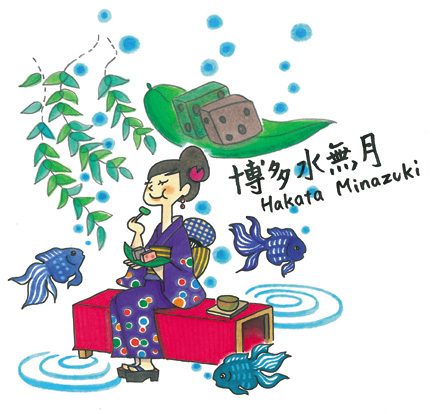Hakata Culture vol.42
Hakata's Special Summer Sweet

Fukuoka is reputed to be the birthplace of manju in Japan. Shoichi Kokushi, the founder of the Shoten-ji Buddhist Temple near Hakata Station, studied in China during the Sung Dynasty and brought what he learned back to Japan. One of the things he learned was the recipe for manju. More recently, another famous Japanese confection made only in the summer was created here ― Hakata Minazuki.
It was developed by the New Fukuoka - Hakata Wagashi Development Society. The latter was formed by members of the Fukuoka City Wagashi Union which is this year celebrating its 60th anniversary. They worked together to create a new Japanese pastry that would still be enjoyed in 100 years, and the fruit of their efforts was the Hakata Minazuki. It was launched in 1999, which means this year marks its 12th birthday, and many people have been looking forward to the start of sales this summer. The confection is made with adzuki beans and bracken powder, and is wrapped in a blade of bamboo grass. It comes in different flavors, including matcha tea and milk.The name "Minazuki" is the traditional word for June under the old calendar. In Kyoto, the custom has evolved of eating Minazuki on June 30, the halfway point of the year, to help make it through the summer months.
Hakata Minazuki will be available for purchase during the Nagoshi Taisai festival, which will take place at the Sumiyoshi shrine in Hakata Ward on July 30 and August 1. The traditional summer festival of Nagoshi is held at Sumiyoshi Shinto shrines throughout the country to pray for safety from illness and disasters during the season. Incidentally, there are 2,129 Sumiyoshi shrines in Japan, and most of them are next to the sea. The shrines in Osaka, Shimonoseki, and Hakata are known as the three great Sumiyoshi shrines of Japan.
The member shops of the Wagashi Development Society in Fukuoka City will also sell the confection until July 31. Try some―it might help you survive the summer heat!
まんじゅう伝来の地・博多に夏限定和菓子登場!
福岡・博多は日本で最初にまんじゅうが伝来したところといわれます。博多駅前1丁目の承天寺の開祖・聖一国師が、中国・宋にわたってさまざまな技術を身につけ、持ち帰ったうちの一つがまんじゅうの製法だったとか。そんな福岡の地に、名物となる夏限定の和菓子が誕生しています。その名も「博多水無月」。
今年で創立60周年を迎える福岡市和菓子組合には現在60社が加盟、そのメンバーの中から有志が集まり結成されたのが「新福岡・博多の和菓子開発研究会」、100年後でも定番として残っているような和菓子を開発しようという心意気で開発されたのが博多水無月なのです。この和菓子が生まれたのは1999年、今年で12年目を迎え、今ではこの博多水無月の発売を心待ちにしている人たちも多いようです。アズキとわらび粉を主原料として笹の葉で巻かれたもので、これにアレンジを加え、抹茶味、ミルク味なども開発されています。
水無月というのは6月の名称ですが、これはもちろん旧暦のこと。京都では1年のちょうど折り返し地点となる6月30日にこの「水無月」を食べて夏を乗り切る風習が今でも続いています。全国の住吉神社で、夏の無病息災を祈願する「夏越祭」が行われますが、福岡でも博多区の住吉神社で、7月30日(金曜日)~8月1日(日曜日)に「名越大祭」(住吉神社では夏越ではなく名越と書きます)が行われ、博多水無月が数量限定で販売されるようです。福岡市和菓子組合の研究会加盟店でも7月31日まで限定販売。これを食べて、夏を元気に乗り切りましょう!
ちなみに住吉神社というのは、全国に2,129社あるそうですが、そのほとんどが海の側にあり、現在では、大阪の住吉大社、下関の住吉神社、そして博多の住吉神社が日本三大住吉といわれている歴史ある神社なのですよ。

